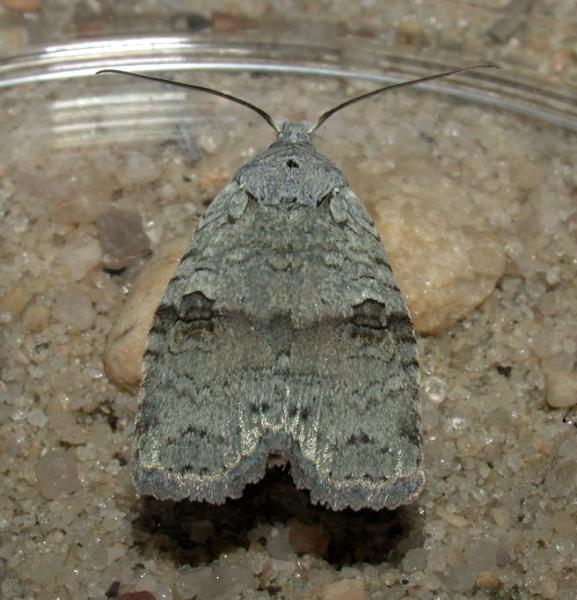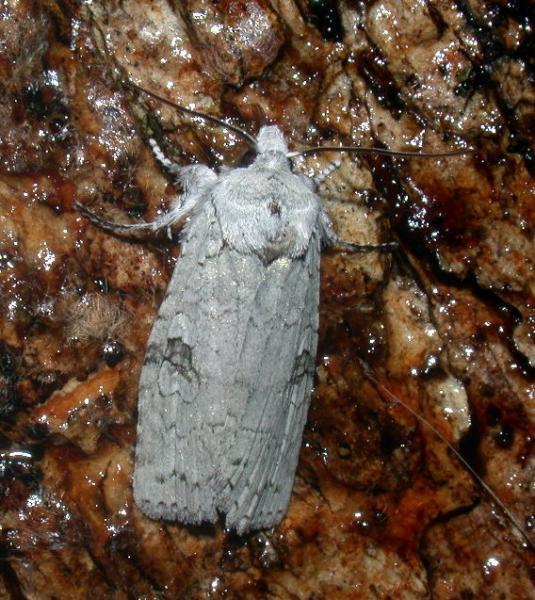Pale Green Pinion Moth
Lithophane viridipallens Grote, 1877
- Class
- Insecta (Insects)
- Family
- Noctuidae (Owlet Moths)
- State Protection
- Not Listed
Not listed or protected by New York State.
- Federal Protection
- Not Listed
- State Conservation Status Rank
- S1
Critically Imperiled in New York - Especially vulnerable to disappearing from New York due to extreme rarity or other factors; typically 5 or fewer populations or locations in New York, very few individuals, very restricted range, very few remaining acres (or miles of stream), and/or very steep declines.
- Global Conservation Status Rank
- G5
Secure globally - Common in the world; widespread and abundant (but may be rare in some parts of its range).
Summary
Did you know?
Latin names for species are often very descriptive. For this species "Litho" means stone and "phane" means to resemble. The second part of the name breaks down into "viridi" meaning green and "pallens" meaning pale. Thus, the name translates to "resembles pale green stone."
State Ranking Justification
Pale Green Pinion Moth (Lithophane viridipallens) appears to be restricted to Long Island. Currently, there are two known locations in eastern Long Island (iNaturalist 2022).
Short-term Trends
The status and trend for this species is unknown for New York State. There are two known areas on Long Island.
Long-term Trends
The long-term trend for this species is unknown. Little is known about the historical range in New York.
Conservation and Management
Threats
The most significant threats to Pale Green Pinion Moth are habitat loss and fragmentation by commercial and residential development (Massachusetts Division of Fisheries and Wildlife 2015). It has been found in pine barrens habitat, but it is not a barrens specialist (McGuinness 2006). Additionally, hydrological alterations to wetlands, water pollution, non-target herbicide use, insecticide spraying, and invasive plants are all potential threats (Massachusetts Division of Fisheries and Wildlife 2015).
Conservation Strategies and Management Practices
Areas where this species has been found need to be evaluated to avoid additional encroachment or fragmentation by development. Maintain natural seasonal flooding cycles in wetland habitats. Invasive and weedy plants can out compete native food plants, therefore proper management and removal of these species should be considered. The use of herbicides and insecticides to control invasive plants and insects can be done if timed carefully (Schweitzer et al. 2018). Large broadcasting of herbicides or insecticides can cause negative effect to host plant species or cause mortality to non-target insects (Schweitzer et al. 2018). As with managing natural habitats, timing to reduce the impact on the species is important, in addition to providing refugia.
Habitat
Habitat
In New York State, the Pale Green Pinion Moth is found only on Long Island. There is one documented location for this species in the dwarf pine barrens. There is another location in the Sag Harbor area (iNatualist 2022). This species is considered more of a generalist occupying many different habitats in the coastal plain including cedar swamps, hardwood swamps, shrub swamps, woodlands, and forests (Wagner 2005). It is often found near stands of Ilex opaca (American holly) or Ilex glabra (inkberry) (D. Schweitzer, personal communication).
Associated Ecological Communities
- Coastal oak-holly forest*
(guide)
A semi-deciduous to mixed deciduous-evergreen broadleaf forest that occurs on somewhat moist and moderately well drained silt and sandy loams in low areas on morainal plateaus. In New York State this forest is best developed on the narrow peninsulas of eastern Long Island. The trees are usually not stunted, and are removed from the pruning effects of severe salt spray. The dominant canopy trees are black oak, black gum, red maple, and American beech. American holly is abundant in the subcanopy and tall shrub layers.
- Coastal plain Atlantic white cedar swamp*
(guide)
A swamp that occurs on organic soils along streams and in poorly drained depressions of the coastal plain. Atlantic white cedar makes up over 50% of the canopy cover. In mixed stands in New York, red maple is the codominant tree.
- Dwarf pine plains
(guide)
A woodland community dominated by dwarf individuals of pitch pine and scrub oak that occurs on nearly level outwash sand and gravel plains in eastern Long Island. The soils are infertile, coarse textured sands that are excessively well-drained.
- Shrub swamp*
(guide)
An inland wetland dominated by tall shrubs that occurs along the shore of a lake or river, in a wet depression or valley not associated with lakes, or as a transition zone between a marsh, fen, or bog and a swamp or upland community. Shrub swamps are very common and quite variable.
* probable association but not confirmed.
Range
New York State Distribution
In New York, the Pale Green Pinion Moth has been reported from two locations in eastern Long Island (iNaturalist 2022).
Global Distribution
This species occurs within 20 miles of coast in Massachusetts, Rhode Island, and on Long Island, New York. It can also be found from southern New Jersey through much of Georgia and west to east Texas. It is unclear how far inland this species occurs, but it seems to occur regularly in northern Georgia and the Raleigh, North Carolina area. Though it has not been found to extend into the Appalachian region. It is probably somewhat common on the coastal plain and piedmont south of Virginia.
Best Places to See
- Dwarf Pine Barrens (Suffolk County)
Identification Comments
Identifying Characteristics
This a very distinctive species. This species has a wingspan of 38-42 mm and can be characterized by its pale, gray-green forewing with double gray-black antemedial and postmedial lines (Massachusetts Division of Fisheries and Wildlife 2015). There is a rust to black color median line that can be present, as well as a black basal dash (Massachusetts Division of Fisheries and Wildlife 2015). A fine black to rust colored shading outlines the reniform spot (Massachusetts Division of Fisheries and Wildlife 2015). The hindwing is a gray brown in color and appears darker around the outer edge of the wing, with a dark discal spot (Massachusetts Division of Fisheries and Wildlife 2015). Both the thorax and head of this species are green gray in color similar to the forewing, while the abdomen is similar in color to the hind wing (Massachusetts Division of Fisheries and Wildlife 2015).
Diet
Little is known about the diet of Lithophane viridipallens though it is speculated that it consists of a variety of acidic wetland shrubs (Massachusetts Division of Fisheries and Wildlife 2015).
Best Time to See
The adult moths are active in the autumn, especially in October and early November.
- Present
- Reproducing
- Larvae present and active
- Pupae or prepupae present
The time of year you would expect to find Pale Green Pinion Moth present, reproducing, larvae present and active, and pupae or prepupae present in New York.
Pale Green Pinion Moth Images
Taxonomy
Pale Green Pinion Moth
Lithophane viridipallens Grote, 1877
- Kingdom Animalia
- Phylum Arthropoda
(Mandibulates)
- Class Insecta
(Insects)
- Order Lepidoptera
(Butterflies, Skippers, and Moths)
- Family Noctuidae (Owlet Moths)
- Order Lepidoptera
(Butterflies, Skippers, and Moths)
- Class Insecta
(Insects)
- Phylum Arthropoda
(Mandibulates)
Comments on the Classification
This is a very distinctive species in the Querquera-Baileyi group.
Additional Resources
References
Forbes, William T. M. 1954. Lepidoptera of New York and neighboring states part III. Cornell University Experiment Station Memoir 329.
Jordan, M. J., W. A. Patterson III, A. G. Windisch. 2003. Conceptual ecological models for the Long Island pitch pine barrens: implications for managing rare plant communities. Forest Ecology and Management 185, 151-168.
Little, S. 1979. Fire and plant succession in the New Jersey pine barrens. pp. 297-313 in Forman, R.T.T. (ed.) Pine Barrens: Ecosystem and Landscape. Academic Press, Inc. Orlando, FL.
Massachusetts Division of Fisheries and Wildlife. 2015. Massachusetts Division of Fisheries and Wildlife [web application]. Massachusetts Division of Fisheries and Wildlife, Westborough, Massachusetts. Available www.mass.gov/nhesp. (Accessed: July 26, 2021).
McGuinness, Hugh. 2006. Overview of the 2005 Dwarf Pine Plains data.
New York Natural Heritage Program. 2024. New York Natural Heritage Program Databases. Albany, NY.
North American Moth Photographers Group at the Mississippi Entomological Museum. No date. Mississippi State University, Mississippi. http://mothphotographersgroup.msstate.edu/MainMenu.shtml
Opler, Paul A., Kelly Lotts, and Thomas Naberhaus, coordinators. 2010. Butterflies and Moths of North America. Bozeman, MT: Big Sky Institute. <http://www.butterfliesandmoths.org/> (accessed May 2010).
Schweitzer, Dale F. Terrestrial Invertebrate Zoologist (retired), NatureServe. Port Norris, NJ.
Wagner, D.L. 2005. Caterpillars of eastern North America. Princeton University Press. Princeton, New Jersey. 512 pp.
iNaturalist. 2022. iNaturalist data download for Lithophane viridipallens on May 24, 2022.
Links
About This Guide
This guide was authored by: Every, Zane W.
Information for this guide was last updated on: June 30, 2022
Please cite this page as:
New York Natural Heritage Program. 2024.
Online Conservation Guide for
Lithophane viridipallens.
Available from: https://guides.nynhp.org/pale-green-pinion-moth/.
Accessed July 26, 2024.

